Rheidol Review
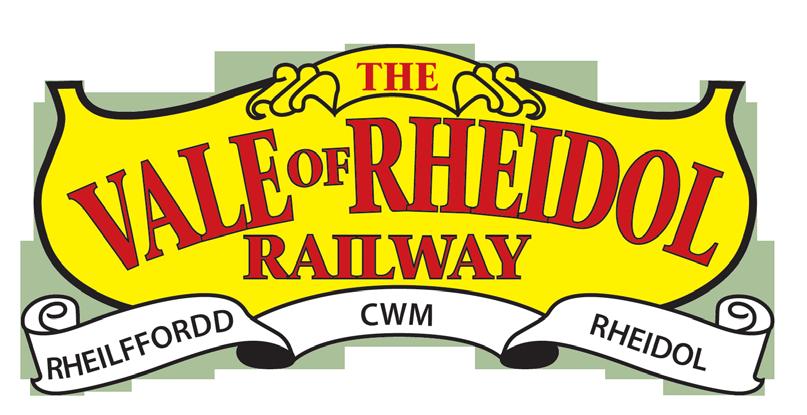
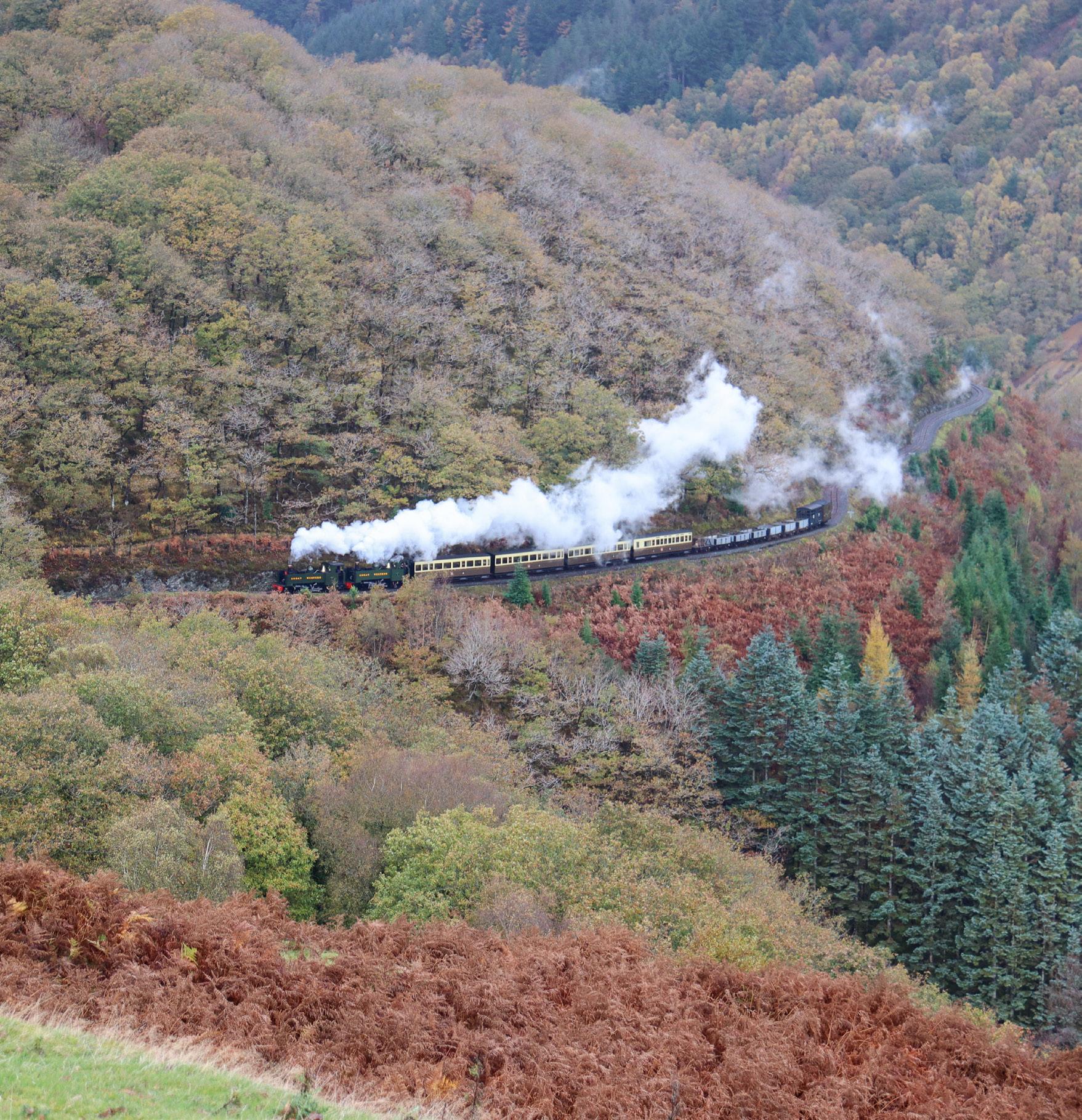
www.rheidolrailway.co.uk Telephone us: 01970 625 819 - Park Avenue, Aberystwyth SY23 1PG Issue 2 - 2022
Newsletter 47
Photo by Andrew Simmonds
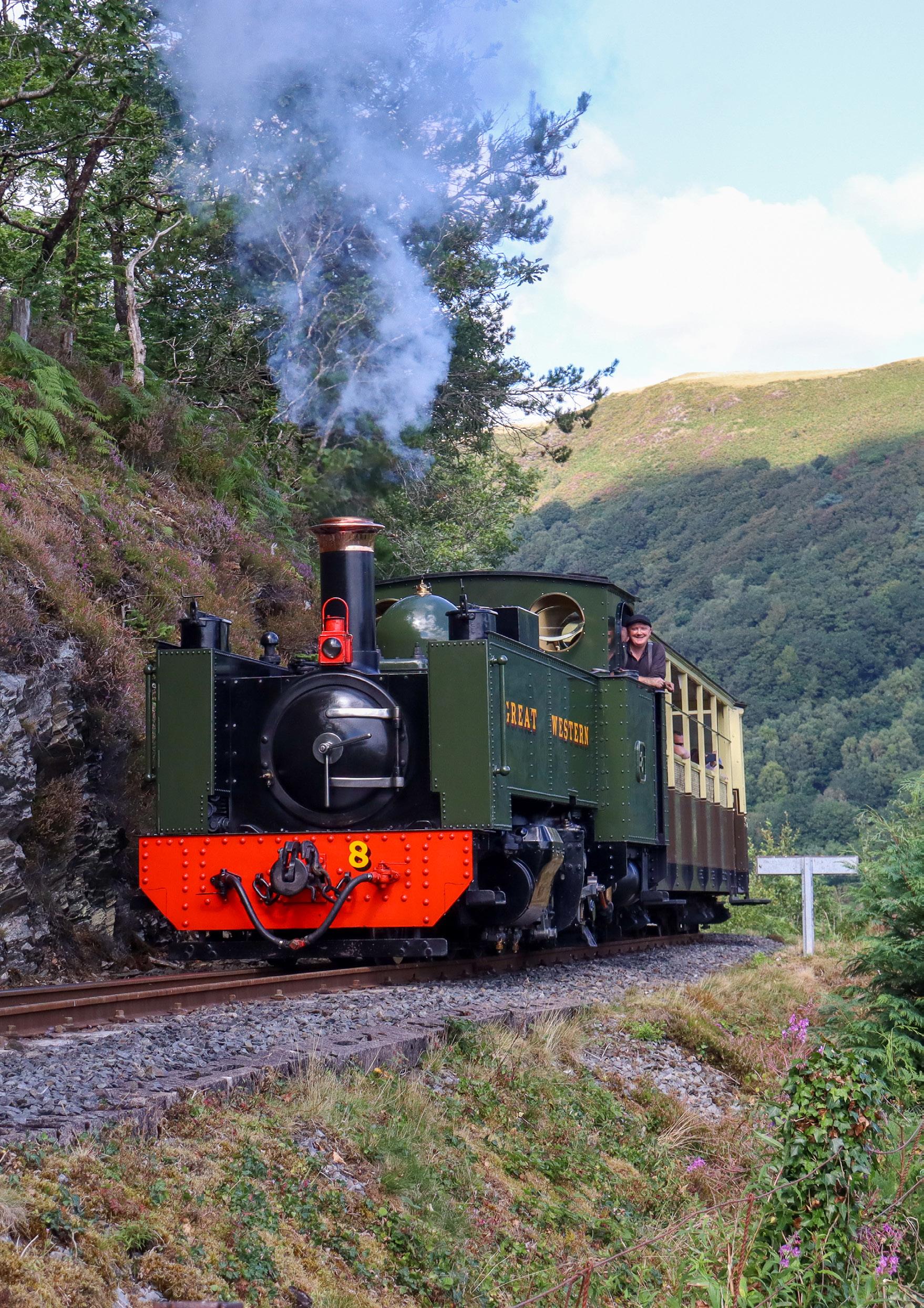 Photo courtesy Andrew Simmonds
Photo courtesy Andrew Simmonds
The summer is fast becoming a memory, the nights have drawn in, and the excitement is growing as the new booking office and multi function display space get closer to completion.
As we move into our winter works period we enter a busy time with lots of things to look forward to, come the spring. We will be moving out of our temporary booking office into our new one and setting it all up and fitting it out, moving our offices into the new facility. In the spring exhibits for show in our display space will be prepared ready to go in the building, and the track isn’t even laid yet to get the engines into it, though that is coming very soon.
Whilst all this work is going on in our Aberystwyth site, up the line our permanent way team are very busy with a goal of laying 1,500 new sleepers this winter as well as the usual spot works to keep our track in top condition, they will also be laying the rails into and through our display space connecting it to the rest of our Aberystwyth trackwork. I imagine as a result several mugs of tea will be drunk on breaks to keep warm in the cold winter air. This doesn’t include the valuable behindthe-scenes work our small team of volunteers will be up to, ensuring that our flower beds look their best, ready for when we re-open in March by nurturing the
plants in their own greenhouses ready for adding to our stations and platforms in the spring.
In our workshop they continue to be busy with lots of contract work under way and No.9 planned for its 10 yearly overhaul next year too, which means there is lots going on this winter to keep our team of skilled engineers and apprentices busy. The paint shop is extremely busy too with a number of carriages to receive a fresh coat of paint and a little tlc this winter to keep them looking at their best ready for next season.
In the last editions ‘Engines from our collection’ article we looked into the history of our Lawley engines and one of our lovely readers, John Browning, has provided some extra information, which I have added to the end of this editions article, thanks John.
Feel free to get in touch by email via newsletter@rheidolrailway.co.uk
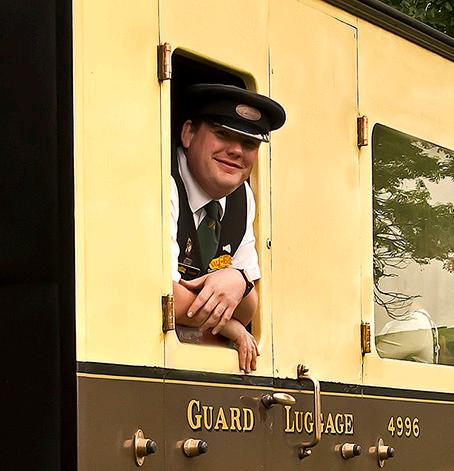 Gareth D Jones Editor
Gareth D Jones Editor
Page 3
Page 4 News Page 10 Workshop Updates Page 17 Then & Now Page 18 Picture Gallery Page 22 Permanent Way Update Page 24 Volunteer Update Page 26 Engines from our Collection Page 30 Gwaithcoch Mine Explored Page 32 Meet the Team Page 33 Reviews Welcome C O N T E N T S
Developing our future...
Vale of Rheidol Railway News
VoR Announces Partnership with Cambrian Mountains Initiative
A popular Ceredigion attraction, the Vale of Rheidol Railway, has signed up to support the work of the Cambrian Mountains Initiative.
Leading by example, the Vale of Rheidol Railway’s injection of funds has allowed the initiative to continue its promotional activities for the next twelve months.
The Cambrian Mountains Initiative has promoted the region extensively over the last five years, and according to Steam Railway Operator, is vital for the success and prosperity of businesses in this region of Wales.

“We think the Cambrian Mountains Initiative has done a marvellous job of raising the profile and awareness of this unique part of Wales,” said Llyr ap Iolo, Director of The Vale of Rheidol Railway.
“The way they approach the promotion of the area has been both creative, engaging, and fresh and I’m sure that many businesses have benefitted from their work over the last few years. Their work needs to continue,
to build awareness of a fantastic part of our country benefitting both our visitors and our communities equally”
The Cambrian Mountains Initiative, with its many partners and supporters, has been at the forefront of promoting the area including stories in newspapers and magazines as well the utilisation of various social media channels.

Its brand-new website highlights this Area of Astounding Natural Beauty and its continued relationships with travel writers and bloggers has also increased the mountain range’s profile.
“We’re so pleased that the Vale of Rheidol Railway values our work and have decided to support our marketing activities over the next twelve months,” said Dafydd Wyn Morgan, Projects Manager at the Cambrian Mountains Initiative.
“We look forward to working closely with them,” added Dafydd.
Page 4
Vale of Rheidol Railway News
The Astounding Cambrian Mountains
The Cambrian Mountains rise up in the very heart of Wales, a place where hills, river valleys and meadows have sustained life for millennia.

Surrounded by the counties of Ceredigion, Powys and Carmarthenshire, and encircled by three national parks, this is a landscape which is steeped in Welsh history and heritage, and where agriculture, language and culture are entwined.
The Cambrian Mountains contains some of the darkest skies in Europe and interest is growing from visitors who choose this unspoilt area as a destination for stargazing.

Come and see the shimmering Noctilucent clouds in the midsummer sky between June and late July. Gaze in awe at the Milky Way stretching majestically from horizon to horizon from autumn onwards. A myriad of stars sparkle in inky black skies during the winter and spring months.
This Cambrian Mountains of Wales has nine Dark Sky Discovery Sites which are easy to access by car and free from man-made light pollution. If that wasn’t enough, there is an IDA International Dark Sky Park (Elan Valley Estate), an area recognised for “possessing an exceptional or distinguished quality of starry nights and a nocturnal environment that is specifically protected for its scientific, natural, educational, cultural heritage, and/or public enjoyment.”
Come and discover the Cambrian Mountains Astro Trail. Extra information available from www.cambrianmountainsdarkskies.co.uk
Photos courtesy Dafydd Wyn Morgan.
https://www.thecambrianmountains.co.uk/
Page 5
Vale of Rheidol Railway News
Project Phase 3 - Multi Function Display Space
Phase3 of our Wales to the World project has been progressing since our last update with lots to share.
The end steels of the building, centre and door posts, were sadly condemned and have been replaced with new metalwork.
The brickwork was removed from four of the side bays of the building facing our car park as the brickwork will be getting replaced with full height curtain wall glazing panels.
The ridge of the shed roof has had its glass panels reinstated, these were removed in 2014 after becoming damaged in storms and were no longer deemed safe, and it has made a huge difference to the natural light being let into the building.
The outside faces of the buidling have had external wall insulation
installed and this has been covered with brick slips to mimic the original appearance of the former standard gauge engine shed.

The roof interior has been clad in a style that replicates the original ceiling, having been internally insulated under the original ceiling.
A new floor has been poured in the building to provide a level concrete surface on which to affix the rail that is also deep enough to cover the electrical conduit laid on the floor.
The first rails have been installed in the shed and the rest will be laid upon completion of the pouring of the concrete floor due by the time this newsletter is published.
For more on our Wales to the World project see; https://www.facebook.com/VoRWalestotheWorld
Page 6









Page 7
Vale of Rheidol Railway News Project Phase 4 - New Booking Office

Phase4 of our project, the construction of our new booking office has also continued at a reasonable pace with completion of the building exterior on the horizon.
As soon as the concrete floor slab had set, work commenced with the blockwork for the walls of the building and the steel support posts for the entrance canopies were installed. The steel support posts will have reclaimed original GWR brackets for a canopy installed on them upon completion of the buidling exterior.
Whilst this work was taking place the old booking office was recycled and moved to a new position where it will be repurposed as a storage buidling.
The brickwork that would form the outer wall of the booking office was designed to match the appearance of our workshop with period features incorporated, as the brickwork
commenced, work turned to the roof of the building.
The roof has been formed from a timber framework truss allowing the roof over the customer-facing section to be open and airy with velux windows to allow more natural light into the space, and the roof section over the offices and counter will be fitted with a loft space for additional storage.
After completion of the framework the roof has been felted, batoned and is now being slated over.
Work has now commenced on the interior walls that will separate the offices, and the work has begun to prepare the office space in the rear of the building.
For more on our Wales to the World project see; https://www.facebook.com/ VoRWalestotheWorld
Page 8








Page 9
WORKSHOP

Baldwin No.46699
Workon the Baldwin has been continuing steadily with the engine starting to come together, for the final time. 46699’s boiler has passed its hydraulic test and been test steamed before fitting in the frames. The rolling chassis is complete, the boiler lagging is being fitted and work on fittings and final plumbing will commence shortly, and it will be in steam for the first time in many years during 2023.



Page 10







UPDATE Page 11
Carriage 12

The fitting out of the handcrafted interior of our second first class carriage has been gathering pace with it due to enter traffic in the spring. This second carriage will have a few unique features that will differ from our other first class carriage, one being another unique painted ceiling by the famous wildlife artist Terence Lambert.




Page 12
WORKSHOP
Diesel No.11


Throughout the summer work was undertaken to adapt the recently acquired diesel No.11 to make it more suitable for our use. This work has seen the fitting of a large compressor for the air braking system, fitting of external brake hoses to connect with our stock and adapting the coupling to match the system used on our line. Once this work was complete the engine was repainted to match the livery of diesel 10, a rather fetching colour scheme which suits their profile well. This now provides the railway with a second diesel able to perform all duties required on the railway.


UPDATE
Page 13
WORKSHOP
Other Projects

Our engineers have as always been busy with lots of external engineering work. We have been undertaking a chassis overhaul of Talyllyn Railway’s carriage No.4. We have been turning and profiling the wheelsets from the Welshpool & Llanfair Light Railway’s diesel. Work has also been continuing on the overhaul and improvements of a pair of unique bogies from the Isle of Man Steam Railway. For our own stable of engines our winter maintenance is well underway; routine mechanical maintenance and boiler washouts are complete. The cold boiler exams have been carried out and work will start on reassembling ready for steam testing early in February. Our fleet of carriages have had their thorough mechanical winter inspections and maintenance completed, this included NDT testing of all the axles, and all the coaches have been deep cleaned inside and out ready for next season.



Page 14







UPDATE Page 15
DMU’s on the Mainline.

The above photo courtesy John Reeves Collection. The below photo courtesy Simon Reeves, taken in October 2022.

Page 16 Then & Now
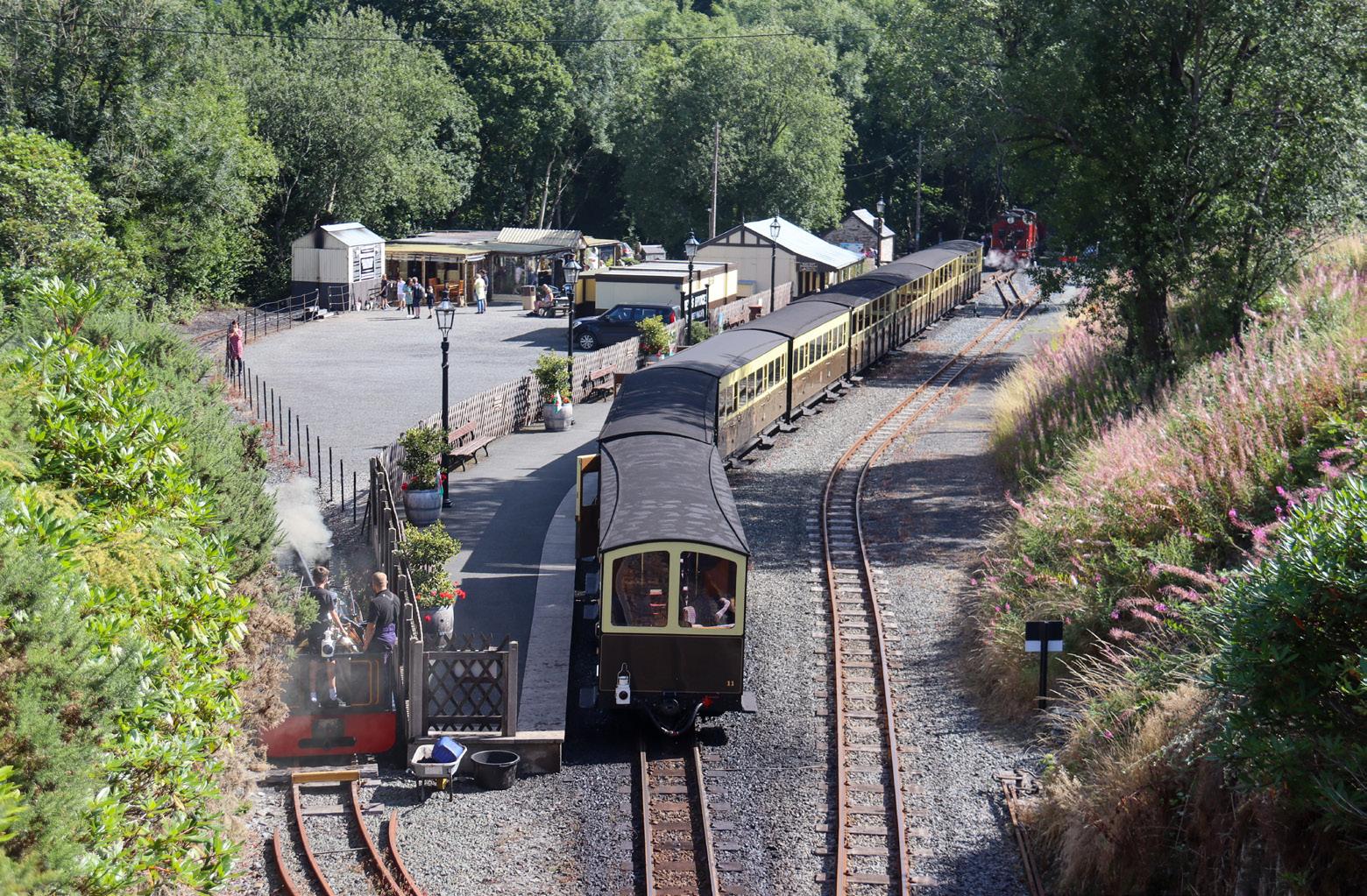
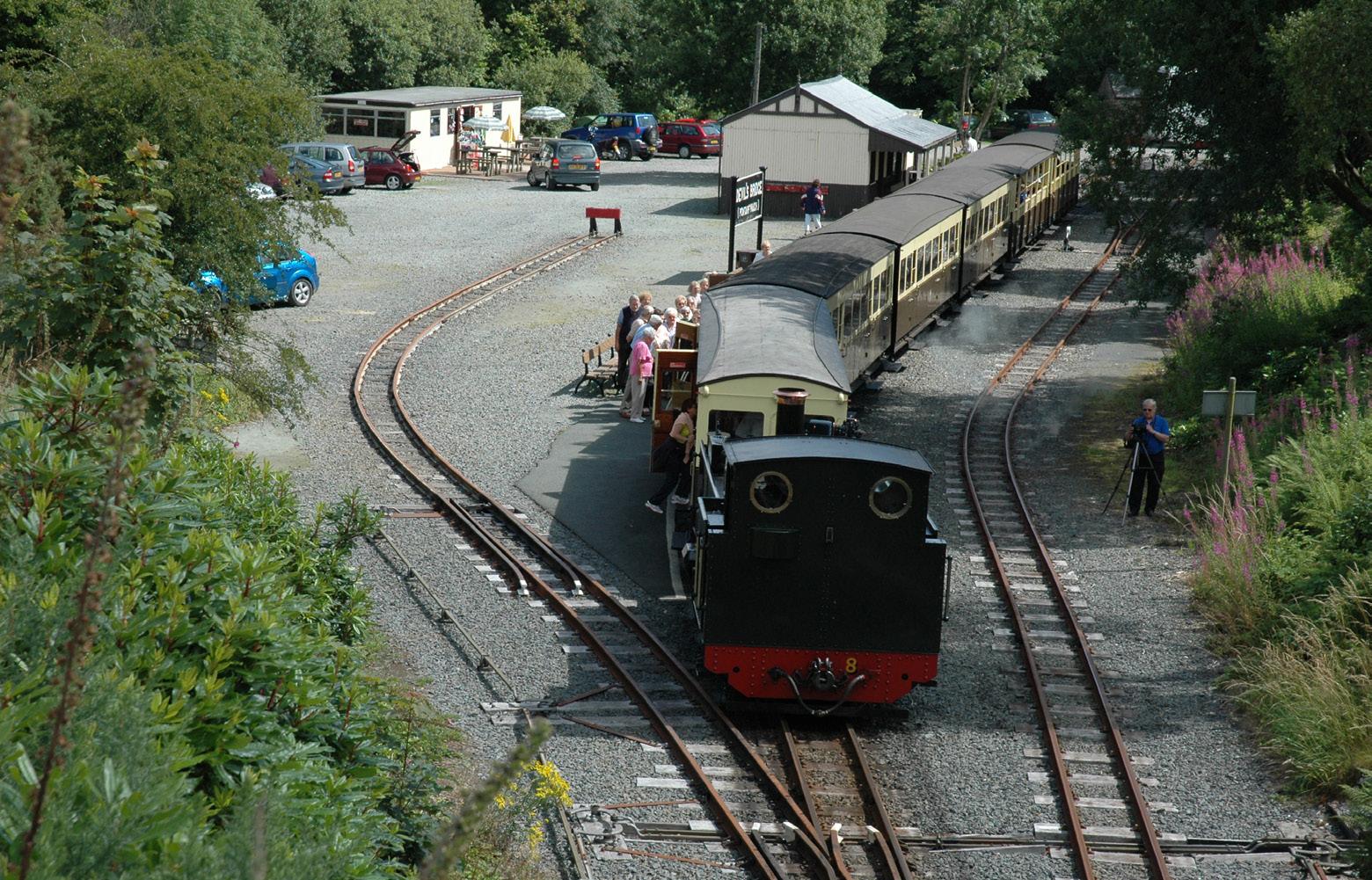
Page 17
Then & Now
Devil’s Bridge seen 17 years apart. The above photo courtesy John Reeves Collection, taken in August 2005. The below photo courtesy Andrew Simmonds, taken in August 2022.
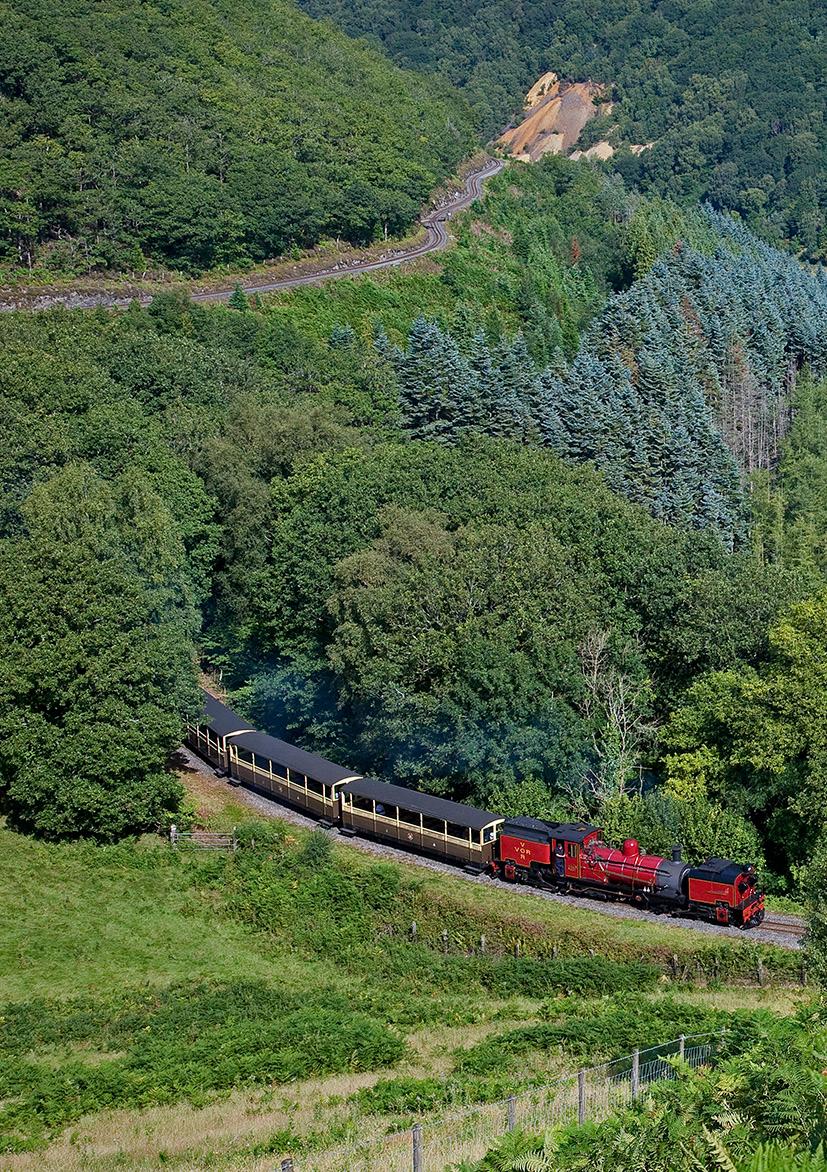
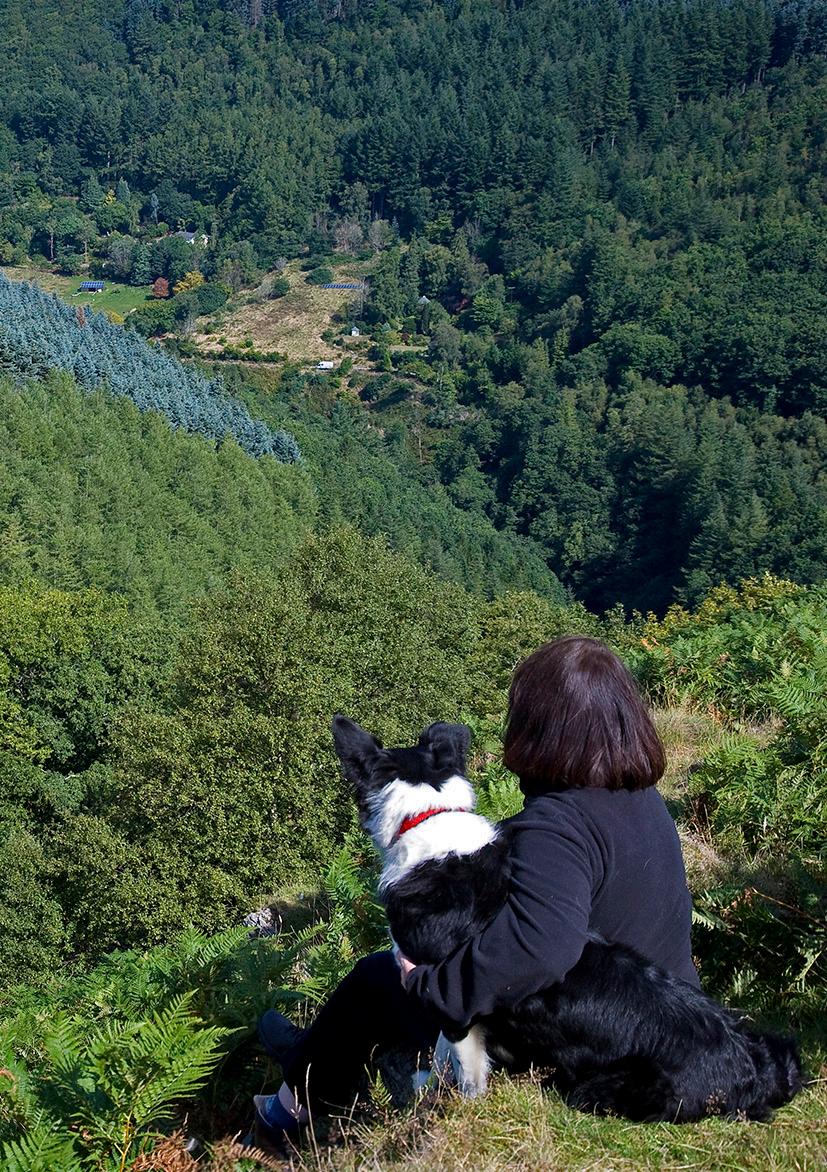 Photo courtesy John R Jones
Photo courtesy John R Jones
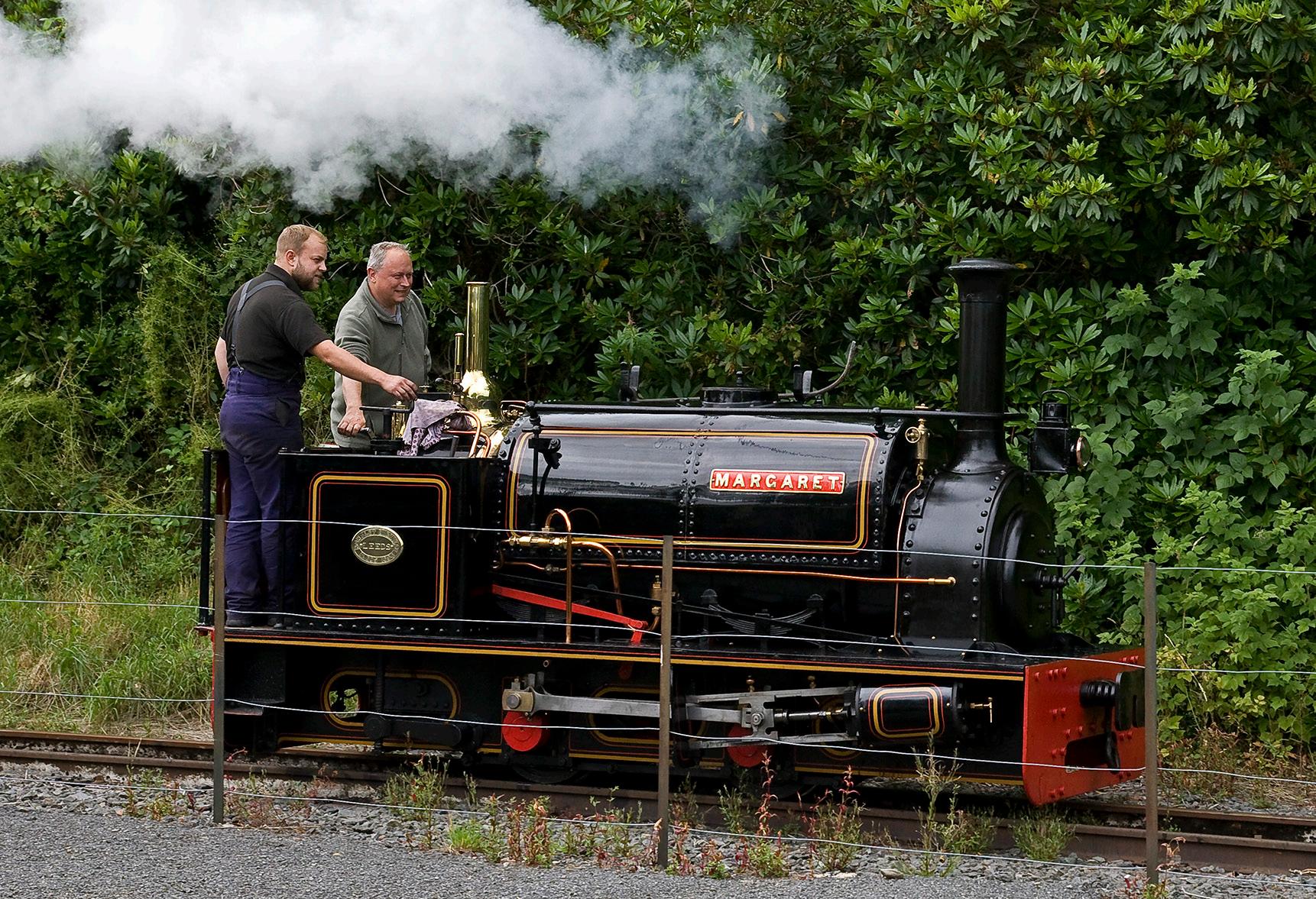
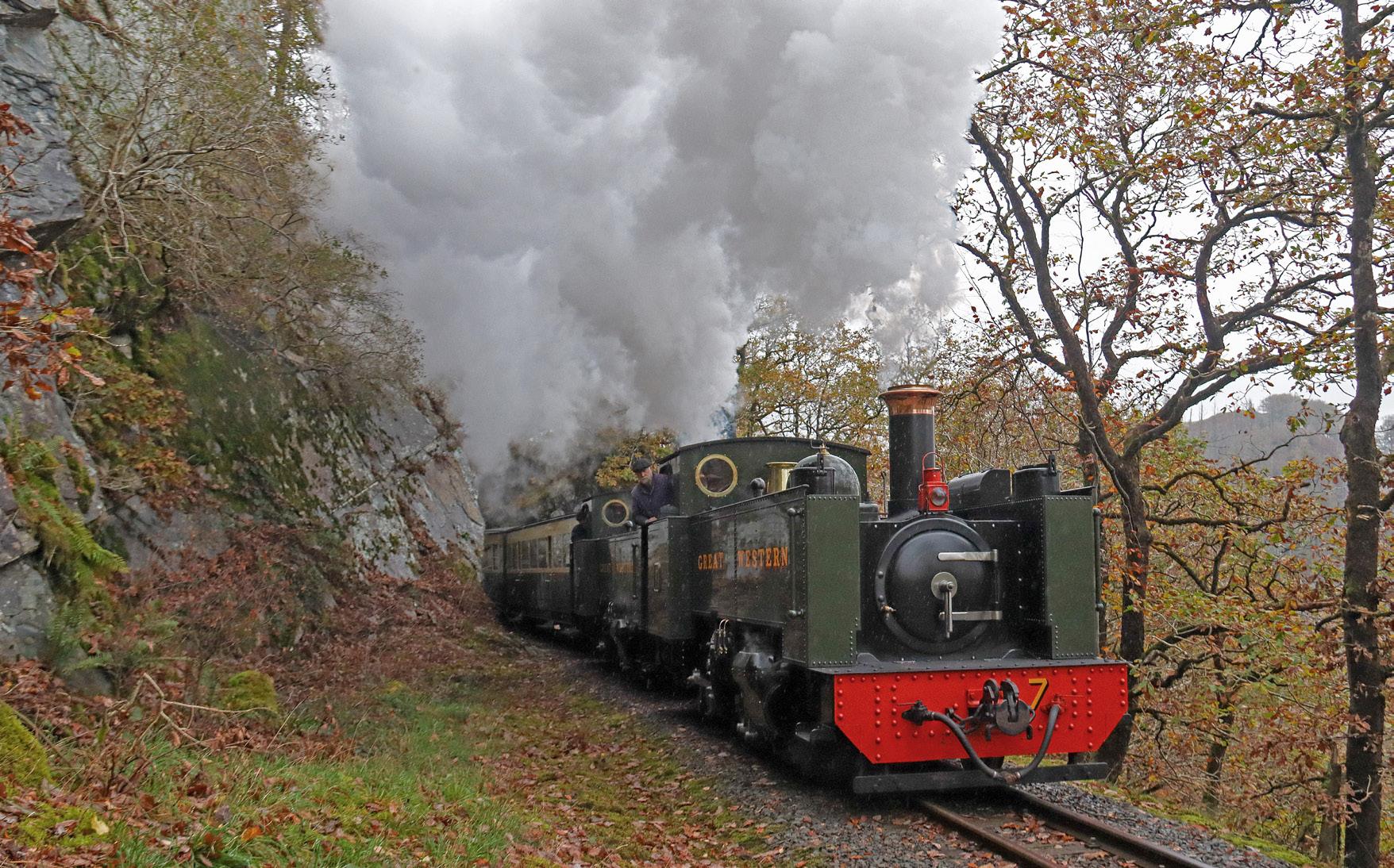
Picture
Photo: John R Jones
Photo: Andrew Simmonds


Gallery
Photo: John R Jones
Photo: Andrew Simmonds
Permanent Way Update
by Ben Brotherwood
Summerfor the Permanent Way team has been a varied challenge with the unprecedented levels of heat causing multiple problems. Not the summer of routine maintenance and odd jobs originally expected but the railway made it through still.

The fire risk necessitated spending several weeks following service trains through high risk areas to ensure no stray sparks or embers escaping the engine had started any fires in the kindling-like vegetation.
Heat movement in the rail created
Page 22
multiple kinks that required trains to slow down for safe passage until the opportunity to reach them and bend the rails back into alignment using our Hydraulic rail bender could be taken.
When laid, a gap is left between each rail length to allow for expansion and contraction. The extremes of heat this year have unfortunately surpassed the stress tolerances of several insulated joints which are either nylon or wood based, leading to several breakages. Aside from this, the track held up well to the extremes with some coaxing over the weeks and trains were able to continue operating safely.
Capel Bangor’s storage sheds have received a lot of attention, the opportunity being taken to remove and store unneeded items at another site, freeing up space to move more of the buildings stored there inside for safety and creating a tidier appearance.
Time was found at the closing stages of the summer to cut back the three
large embankments at Aberffrwd, Cwmdaudder and the Little Horseshoe. If left unmanaged, eventually the banks would have multiple large trees growing through which could lead to destabilisation. Hacking back the brambles also gives other plants the chance to grow through in future for variety. The extreme angle of the embankments did require some extra safety measures, using a winch and harness to safely move across the surfaces. Several of the embankments end with rather steep gullies best avoided for personal preservations sake! The view down them is impressive though and now more visible for passengers sitting on the right sides.
Heading into the fall, the team is looking forward to working in the museum to lay the rail for the exhibits. Winter will see another long relay, escaping Section A, heading out from Capel Bangor into the woods to Tan Yr Allt.

Page 23
Vale of Rheidol Volunteers
 By Clive Higgs & Jenny Edwards, Railway Volunteers
By Clive Higgs & Jenny Edwards, Railway Volunteers
Annie was a very intrepid volunteer, happily carrying buckets of water in her wheelchair, across rough ground and along the station platform at Capel Bangor.

summarizing: ‘It has been a busy season for volunteer involvement with the VoRR. Tasks have ranged from preparing and painting a station building and a water tank, to maintaining floral displays at their best amidst what can only be described as challenging conditions. The great thing from my point of view as a newer volunteer is to learn new skills and to just have a go at something different, to do your bit whilst being part of a bigger picture.’
By June, the Aberystwyth Station’s gulls seemed to have stopped digging up the violas and primulas and had moved away, perhaps in search of people’s fish and chips. The volunteers were driven by the weather instead. The routine of meeting just once a week was dropped for months.
We shall miss her sparking smile and sense of humour. Annie died on July 7th after a long illness, devotedly looked after by Jenny.
Jenny returned to volunteering and was soon working at every session and
During the dry spells there was watering at Aberystwyth, Capel Bangor, Nantyronen, Aberffrwd and Devil’s Bridge every few days. In the wet spells the geraniums at these places needed deadheading .and the weeds needed clearing The isolated Rheidol Falls and Rhiwfron halts had no plants needing
Page 24
watering but their banks were cleared of brambles and aggressive weeds. The mountainous clematis montana hedge at Rhiwfron grew over the platform seat and sat down there. We were able to see the seat after an hour of trimming and to sit on it after two. There were several trips to find and clear the footpath above Rheidol Falls. The buildings of the intermediate stations and halts were cleaned.
John and Clive painted the smaller water tank on the bank opposite Aberffrwd Station. It was hidden by overgrowth. We had to cut a path to it and around it but couldn’t step back and see it overall. Until later, when the permanent way gang cleared the view.

Seven volunteers turned out to paint Aberffrwd Station including the original volunteers Maurice and Mark. A very
sociable time, especially with the chorus of ‘You’ve missed a bit!’ from laughing passengers.
Now, the station can be seen from the revealed water tank.
The autumn jobs were weeding at all the stations, appreciating kneepads and planting narcissi bulbs at Devil’s Bridge. After the trains hibernate in November, we planted lots of tulip bulbs and moved the 25 boxes of geraniums in the Nantyronen platform troughs inside the waiting room to protect the plants from frost. The 25 boxes of bulbs that were parked outside the building were put into the platform troughs.
A very busy period for the volunteers: Philip, Edwina, John, Mark, Maurice, Jenny, Clive and Maureen, who looked after the Aberffrwd gardens alone.
Our volunteers meet once a week, and through their efforts our stations always look at their best no matter what the weather. If you wish to join our amazing band of volunteers helping to maintain our stations then please get in touch via email: info@rheidolrailway.co.uk
Page 25
Engines from our Collection
Compiled by Gareth Jones
Ruston Proctor ZLH Paraffin Locomotive
This paraffin mechanical locomotive is believed to be the oldest narrow gauge internal combustion locomotive in the British Isles. It is still in original condition. It was constructed to a gauge of 3’3” (metre gauge). Its original identity is unknown, it is either No 50823 of 1915 or No 51168 of 1916 Built for service at for the Cotton Powder Co of Faversham, Kent. It’s intermediate history is unknown but we know it ended its days at English China Clay’s Blackpool Works in St Austell, Cornwall although its use was minimal. It was saved for preservation by Rich Morris in 1963 moving to Kent. In 1978 it moved to Gloddfa Ganol in Blaenau Ffestiniog before being acquired by the Vale of Rheidol Railway in 1997. Restoration was started by Allen Civil and will be completed in the VoR workshops. A similar locomotive, No 52124 of 1918 is on static display at the Museum of Lincolnshire Life.

Left: Locomotive 52124 of 1918, On static display at the Museum of Lincolnshire Life Right: Hudswell Clarke D564 and Ruston Proctor await their turn in the overhaul queue


Page 26
Engines from our Collection
Compiled by Gareth Jones
Still from a youtube video by earthfire featuring NG15 No.17 at Sandstaone https://www.youtube.com/watch?v=FwQPC_NIoUY
SAR NG15 (2-8-2)
The South African NG15 class engines were built by two different companies over a period of 26 years with the first batch being built in 1931 and the last as recently as 1957, with the class eventually totalling 21 engines. Built as a development of the earlier South African NG5 class they were originally ordered by South African Railways (SAR) for use on the Otavi Railway in South West Africa. The NG15 engines were built with a clever solution to help negotiate the tight curves typical of narrow gauge railways, they featured a Krauss-Helmholtz Bissel Truck, this meant the leading driving wheels of the engine had some sideplay and had the leading Bissel Truck linked to it, this helped to steer the engines into the tighter curves. They were built in five batches, loco numbers NG17-NG19 were the first being built in 1931 by the Henschel und Sohn company in Kassel, Germany. The second Batch of locos numbered NG117-NG119 were completed in 1938 also by Henschel. The next two batches loco numbers NG120-NG124 (built 1938) and NG132-NG136 (built 1952), were completed by a different company Société Anglo-Franco Belge. (The Franco-Belge company had been split into two separate businesses in 1927, becoming the Belgian Société Anglo-Franco Belge and the French Société Franco Belge.) The

Page 27
final batch of five engines were completed by Henschel and were initially numbered TC1 - TC5 having been purchased by SAR for use on trains with the Tsumeb Copper Corporation, they later became NG144 - NG148.
In 1960 the Otavi Railway was regauged to Cape Gauge and all 21 locomotives were transferred to the Eastern Cape and put to use on the line that ran between Port Elizabeth and Avontuur. The arrival of the twenty one NG15’s on the Avontuur line almost doubled the number of engines on the line when they were delivered, taking the number of locomotives from 23 to 43. Whilst on the Avontuur Railway the NG15s gained the nickname ‘Kalahari’s’ taken from their previous region of operation. The class become favourites of the loco crews on the line due to having more space on the footplate, being fast and free steaming, they also had similar haulage capacity to the Garratts that had been the mainstay of operations on the line prior to the arrival of these engines.
In the Vale of Rheidol Collection there are two NG15s: the Société Franco Belge built NG121 and the Henschel built NG146. When researching the history of our two engines one presented more of a challenge than the other. NG121 was a challenge to research with only one photograph being found of the engine to date on the Soul of a Railway Website (A fantastic website for fans of all things South African Railways), this featured the engine derailed after an altercation with a double decker bus. Little other mention of the engine seemed to have been available. NG146 on the other hand has had a much higher profile, and a much more photographed career. Upon the Avontuur line converting to diesel use, it was sold to a private owner and employed on the Alfred County Railway where it was the sole NG15 in use and very popular with photographers and enthusiasts alike, remaining operational until 1998 when it was last used for the tourist Banana Express trains alongside the remaining NGG16 engines. NG146 was moved to the docks in South Africa in September 2001 from where it was imported to the UK, going initially to the Brecon Mountain Railway before moving to the VoR’s Surrey site.
Research for this article on the collection have been compiled from the following sources; https://sites.google.com/site/soulorailway/soul-of-a-railway?authuser=0 https://en.wikipedia.org/wiki/South_African_Class_NG15_2-8-2
Further information on our Lawley engines from John Browning; We can be sure that Falcon 265 and 266 were brought to the UK by Peter Court as part of a large consignment of locomotives from Mozambique in or about 2000.
John Middleton, a notable researcher on industrial railways in southern Africa, indicates that they came from Buzi Sugar Estate. The company had up to five Lawleys, not all of which have been identified. Some at least were in use at Buzi in the first decade of the 20th Century. Four were said to be in use in 1963. Three were left in 1969, dumped. One of these, named M’DUNDO, was later plinthed at the Mill Club and is one of the ones you have. The other you have may be the one that was named LISBOA. The third that survived after 1969 was named LUZITANIA.
A series of photos of the Lawley locos derelict at Buzi commences here; https://www.internationalsteam.co.uk/safari/mozambique501.htm Thanks John for the extra details.
Page 28
Vale



Page 29 shop.rheidolrailway.co.uk
of
Web Shop All the products you would expect to find in our store, online. Can’t find a certain product? Email us shop@rheidolrailway.co.uk
Rheidol
Main Image: Sitting in the c.1750s Gwaithcoch Upper Adit for the first time in over a century, with vertical workings continuing down to the left. Inset: The deep, vertical shaft we descended immediately above the Vale of Rheidol Railway.

Gwaithcoch Mine Explored
by Ioan Lord
Very little historical information is recorded on the Gwaithcoch lead mine, immediately adjacent to the Vale of Rheidol Railway trackbed between Rheidol Falls and Erwtomau.
As stated in Rich Mountains of Lead: the metal mining industry of Cwm Rheidol and Ystumtuen, it is believed that mining started here during the early
nineteenth century, when three adit cross-cuts (levels) were driven south into the mountain to intersect a rich vein of lead-ore and zinc. The lowest of these was not far above river level, and the highest was on the same height as the railway which was built almost a century later. However, new exploration and access to the mine in the autumn of 2022 has

Page 30
enabled a more thorough understanding of the workings to be compiled, as well as proving that the mine is a lot older than previously believed.


On 25 August, myself and a friend abseiled a deep, vertical shaft situated immediately above the railway at the top of the large spoil heap, which descends almost to river level. This shaft soon began to follow the underlie of the lead vein, inclining north at about 70 degrees until we were directly below the trackbed. Here, we were able to access the uppermost Gwaithcoch adit, in which nobody had been since it was blocked prior to constructing the railway in 19012. The passage was barely 5 feet tall and 2 feet wide, being a classic example of mid-eighteenth-century mining in midWales. Very little gunpowder had been used, proven by the scarcity of shotholes, and those holes which we did find were very small and had been drilled by hand, using narrow chisels of no more than half an inch diameter. The entrance to this very primitive level was blocked with rubble excavated whilst cutting the trackbed immediately on top of it. The discovery of such a primitive level at Gwaithcoch has confirmed that
mining began here at least 50 years earlier than was previously thought, possibly as an extension of the Erwtomau Mine workings which were mainly opened during the seventeenth- to eighteenth century. The vertical shaft beside the railway continued even further below the old Gwaithcoch Upper Adit, and into a large cavern (stope) where a rich bunch of ore had been extracted. Here there was an assortment of debris that had been thrown down the shaft from the top, including some old wooden fenceposts from the railway’s early days. The best artefact that was found during this exploration was a very early, primitive wooden wheelbarrow, still standing in the upper adit. The wheelbarrow probably dates from the late eighteenth or early nineteenth century, and contains a simple wooden wheel with a metal tyre. It was seen and photographed for the first time in over a century on 9 September. It is a rare survivor from a time when the mining industry of Cwm Rheidol was gradually expanding towards the zenith which would ultimately lead to the opening of the Vale of Rheidol Railway, over a hundred years later.
Page 31
N.B. These mines are on Private property and entry is forbidden unless by prior arrangement. Mines in the Valley are very dangerous owing to the vertical shafts and the potential for them to be hidden within woodland. Exploration should only be undertaken by experienced persons!
A primitive, wooden wheelbarrow from around 1800 survives underground at Gwaithcoch. It was found for the first time in modern times on 9 September, and sits in a level directly below the railway.
About Our Staff
About our staff
Robert ‘Bobby’ Quayle Engineering Apprentice
Bobby comes to us from the Isle of Man, where he was working as a tram conductor on the Manx Electric Railway. He has a family background in railway engineering and that interest runs in his blood too, especially now he has joined our team as an apprentice. As well as training to become an engineer with us, he is also training as a fireman & guard on our line. In his downtime he likes to strum a tune on his guitar, or get out and about playing football or strapping his skates on for a bit of ice hockey. We welcome him to our team and if you see him about when you visit say hello.

Kian Holdsworth Engineering Apprentice
Kian
is a local lad, living not too far away from the railway in Llangeitho. Before joining our team here at the railway he was in college studying towards a level 3 qualification in mechanical engineering.

Like Bobby he is also training as a fireman and guard alongside his apprenticeship training.
When not at work he likes getting his hands dirty tinkering with cars and engines, and is also into running around forestry indulging in a bit of airsoft. We welcome Kian to our team and if you see him about don’t be afraid to say hello to him.
Page 32
Google Review
Staff are very welcoming. the trains and station are kept spotless. Very impressed. I went with a group who had our own train and entertainment as well as a superb buffet lunch was provided for us a Devils bridge Station
Facebook Review
Fabulous day out! Beautiful train ride through the valley! Kids loved it. Lovely coffee shop at Devils Bridge also. Really good day!!Angela Stadden
Tripadvisor Review
Time Travel by Rail Professional, charming staff. Train equipment well cared for and spotless. First class is a step back in time. Loved it. Trains were on time too!
Facebook Review
Michael S
Google Review
Really great day out. Staff amazing! Had two disabled members in our party and they could not have been more helpful. My son loved driving the little engine at Devils Bridge. Ian Banham
Fantastic ye olde way to travel to the devils bridge. Value for money. Polite, courteous and friendly staff. David Smith
Tripadvisor Review
Exhilerating Trip The thrill of climbing higher as the train twisted and turned its way to Devils Bridge was exhilarating with ever changing view. At journey’s end the delightful cafe was the cream on the cake. Hoodwink7
Page 33
Reviews
Helen Goff
The Vale of Rheidol Railway in Detail
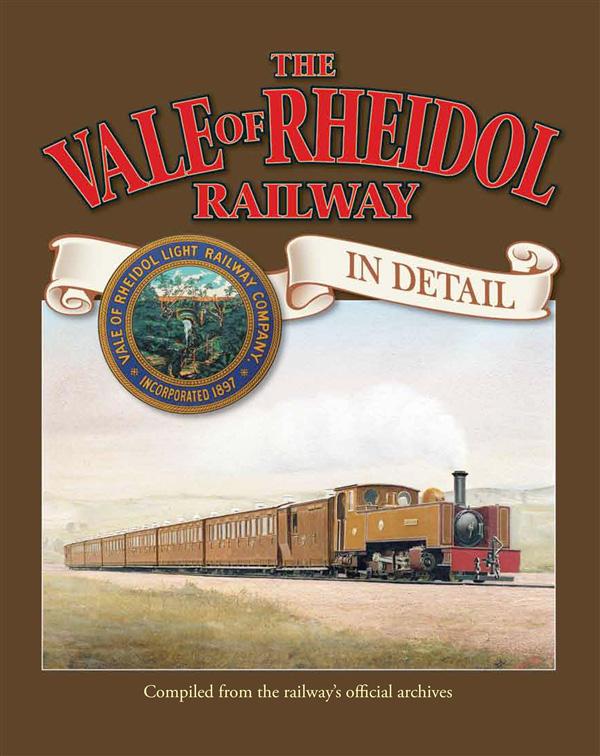
Published March 2022, after five years in the making, this fantastic book brings the technical history of the Rheidol up to date.
It features drawings of all our rolling stock and buildings along with livery diagrams, an ideal resource for modellers and VoR fans alike.
Available for purchase from our website below or come and visit our shop & see what else we have on offer.
https://shop.rheidolrailway.co.uk
Page 34

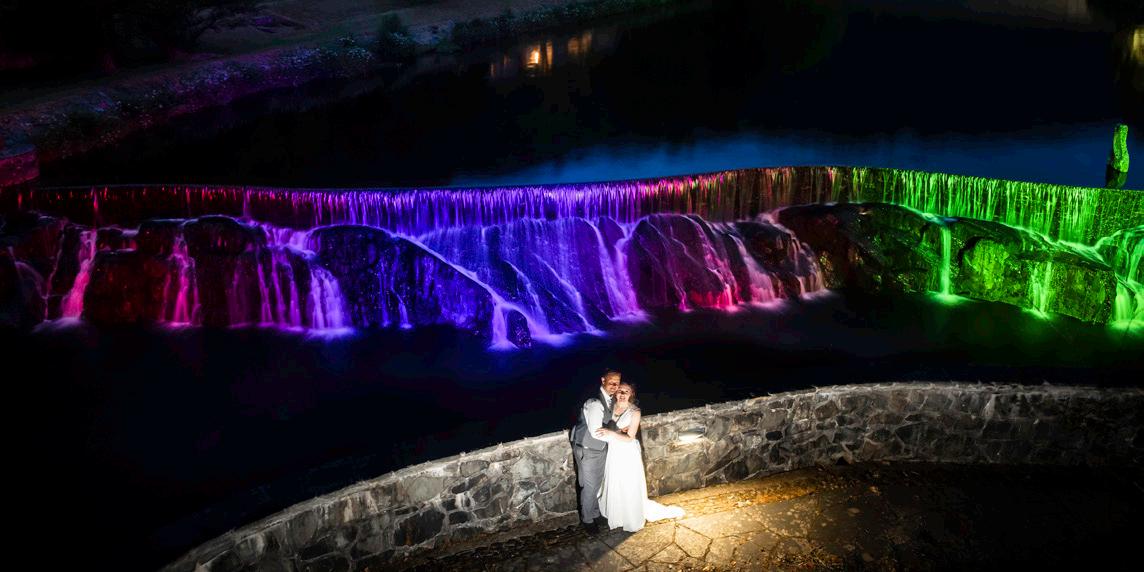

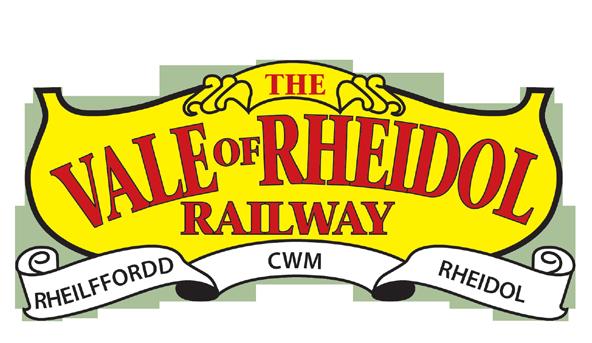



Contact us on 01970 625 819 marketing@rheidolrailway.co.uk www.rheidolrailway.co.uk Park Avenue, Aberystwyth SY23 1PG
a
of opportunities and locations,
Add the Romance of a Steam Train to your Special Day.. Aberystwyth’s most unique wedding reception venue Page 31
With
variety
the possibilities are endless. From using the Steam train to get from the ceremony to the reception venue, or even holding your reception at one of our charming stations. The Railway is completely flexible to make your dream day come true.
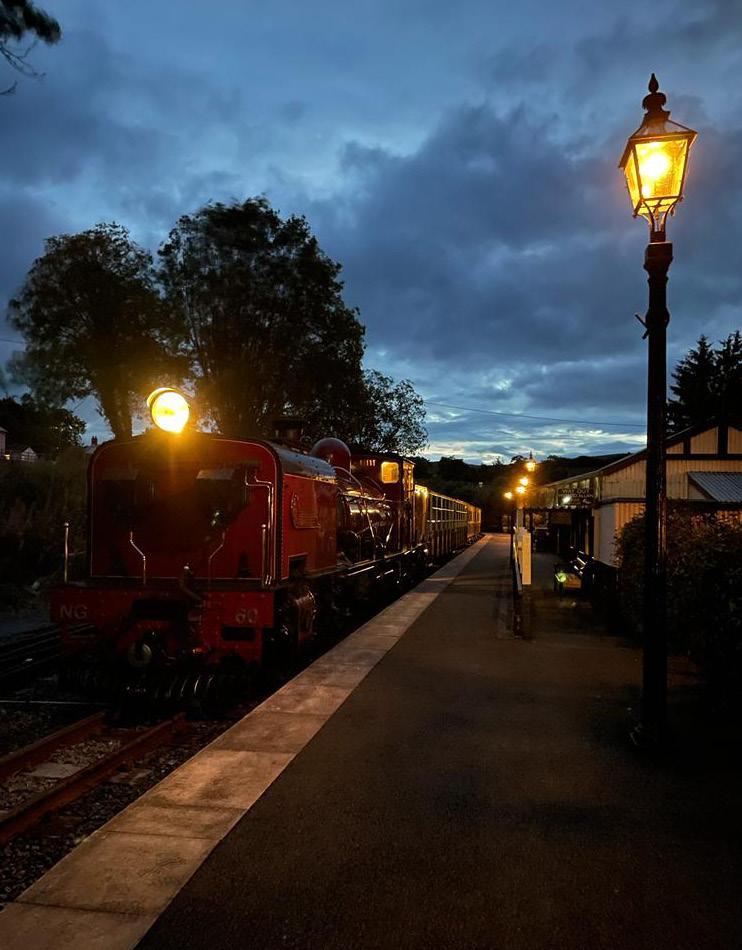

www.rheidolrailway.co.uk Telephone us: 01970 625 819 - Park Avenue, Aberystwyth SY23 1PG
Photo by Simon Reeves


 Photo courtesy Andrew Simmonds
Photo courtesy Andrew Simmonds
 Gareth D Jones Editor
Gareth D Jones Editor
























































 Photo courtesy John R Jones
Photo courtesy John R Jones






 By Clive Higgs & Jenny Edwards, Railway Volunteers
By Clive Higgs & Jenny Edwards, Railway Volunteers
























